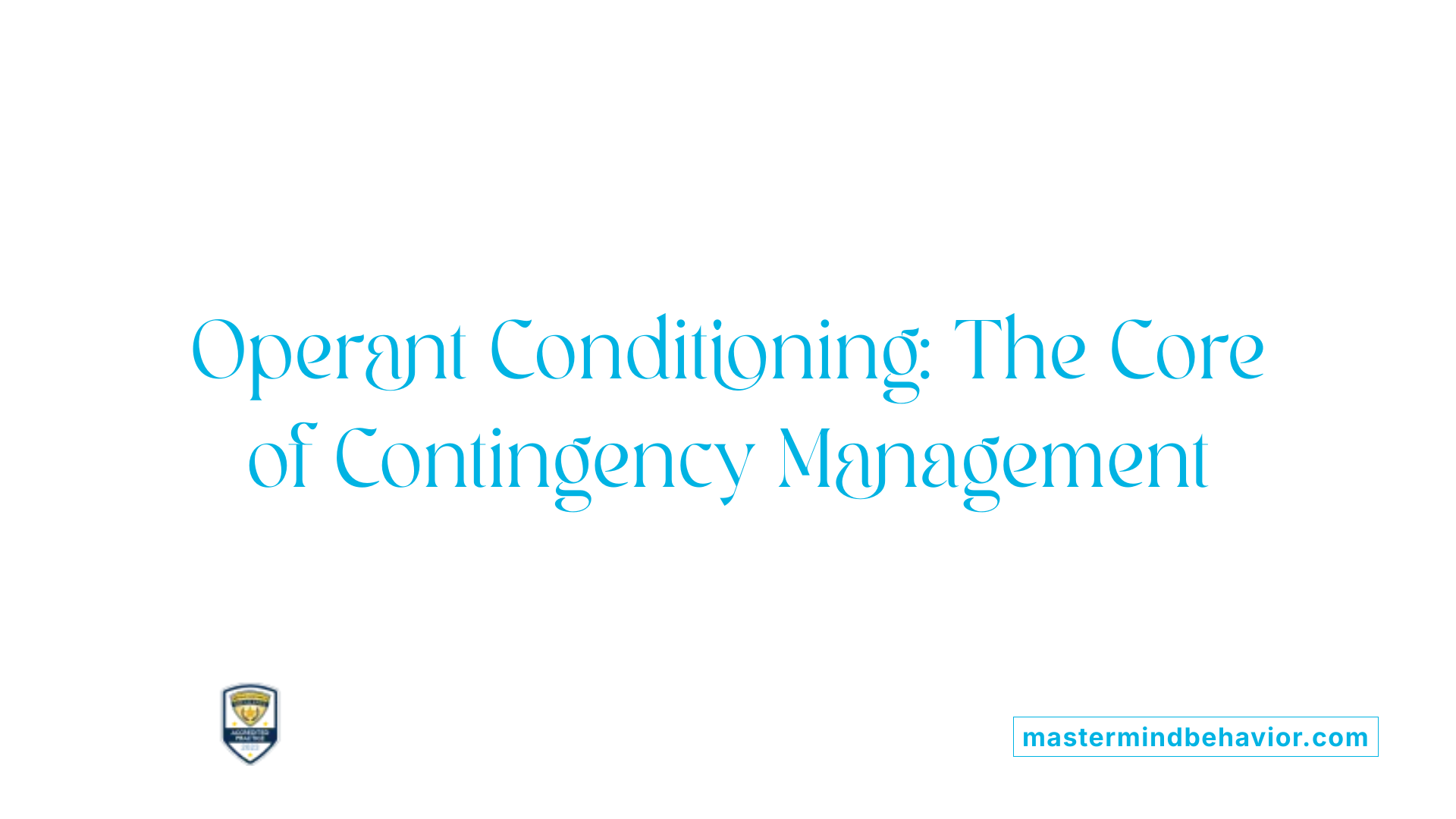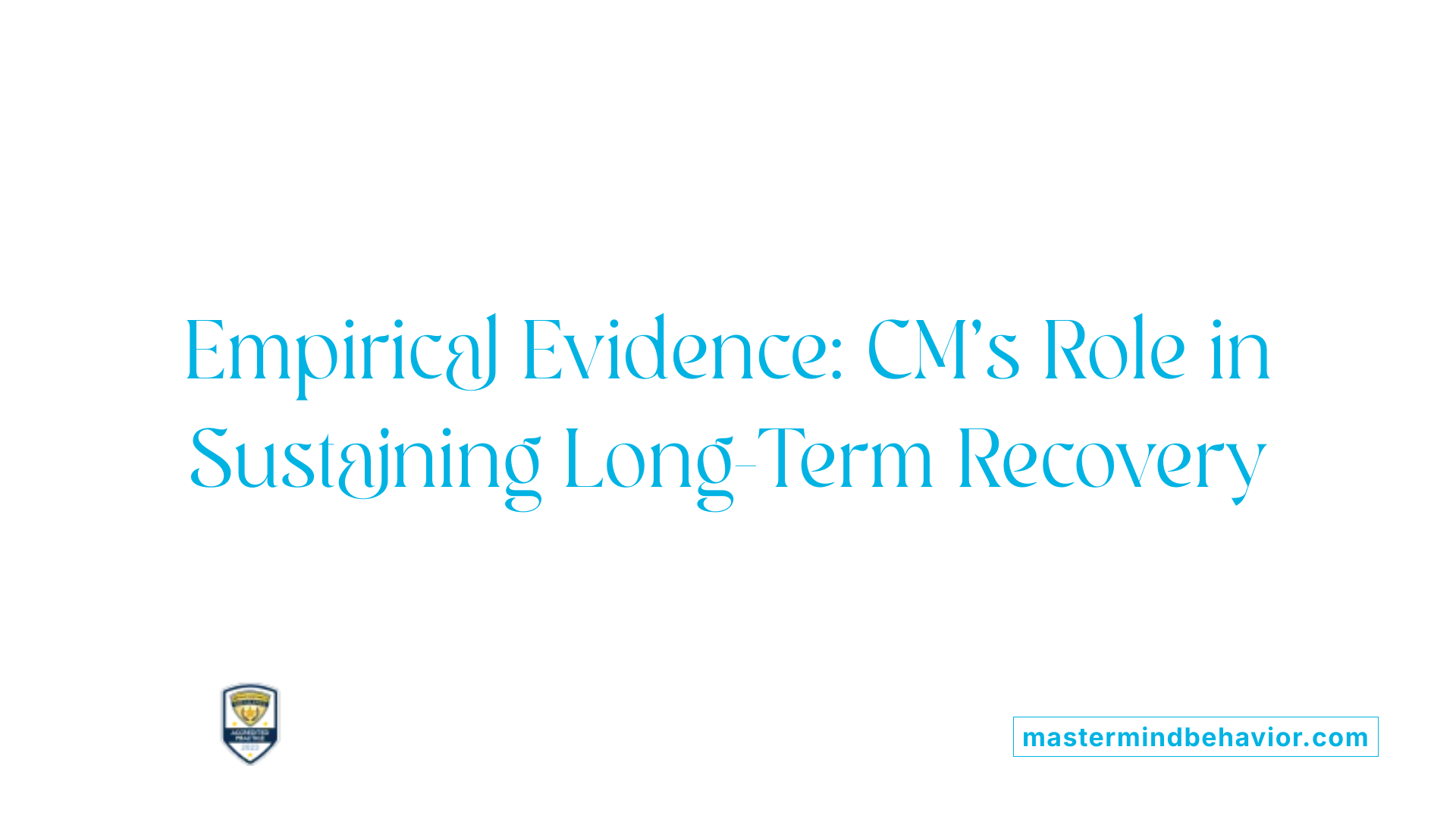Understanding Contingency Management in ABA Therapy
Contingency management (CM) is a pivotal component of applied behavior analysis (ABA), rooted in classical behavioral principles. It utilizes reinforcement strategies, reinforcing positive behaviors through tangible incentives such as vouchers, monetary rewards, or privileges. This evidence-based approach leverages the principles of operant conditioning to modify behavior, making it highly effective across various treatment settings. Despite substantial empirical support, it remains underused due to practical barriers like lack of familiarity, perceived complexity, and cost concerns.
Fundamentals and Principles of Contingency Management

How does operational basis of CM relate to ABA?
Contingency management (CM) is fundamentally grounded in applied behavior analysis (ABA), which applies principles of behavior modification to promote positive change. At its core, CM involves the systematic use of reinforcement strategies—such as vouchers, prizes, or privileges—delivered immediately after desired behaviors occur. These behaviors may include abstinence from substances, attendance at therapy sessions, or adherence to medication regimens.
In practice, CM employs the core concept that behaviors are influenced and shaped by their consequences, a principle central to ABA. This approach ensures that individuals are motivated to display beneficial behaviors by making those behaviors more rewarding and thus more likely to be repeated.
Systems employing CM often involve frequent monitoring, immediate feedback, and escalating reward schedules that reinforce sustained behavioral change. Such structures are designed around ABA's emphasis on environmental influence on behavior, underscoring the importance of context, timing, and contingencies in behavior modification.
What are the operant conditioning principles behind CM?
Contingency management is deeply rooted in B.F. Skinner’s operant conditioning, which posits that behaviors can be increased or decreased based on their consequences.
- Reinforcement: When a behavior is followed by a rewarding stimulus, such as cash or prizes, the likelihood of that behavior reoccurring increases.
- Punishment: Although less common in CM, undesired behaviors can be discouraged through consequences that decrease their occurrence.
- Extinction: Behaviors that are no longer reinforced tend to diminish over time.
By applying these principles, CM strategically reinforces healthier behaviors, such as drug abstinence, by immediately providing positive consequences. Immediate reinforcement strengthens the connection between the behavior and the reward, enhancing motivation and adherence.
How does reinforcement facilitate behavior change?
Reinforcement, the cornerstone of CM, works by increasing the probability that a desired behavior will recur. In substance use treatment, for example, individuals tested negative for drugs receive vouchers or prizes, reinforcing the act of abstaining.
The magnitude and immediacy of reinforcers are critical. Larger or more salient rewards tend to produce faster and more sustained behavior change. Additionally, escalating reinforcement schedules—where rewards increase with continued positive behavior—encourage individuals to maintain long-term abstinence.
This mechanism effectively rewires the brain's reward circuitry by associating healthy behaviors with positive outcomes. Over time, this can diminish the reinforcing power of substance use, and support the development of healthier habits.
Behavior modification mechanisms in CM
In practice, CM involves several mechanisms to foster behavior change:
- Frequent Monitoring: Regular testing (e.g., urine drug screens or breathalyzers) provides immediate data on behavior.
- Targeted Reinforcers: Incentives are carefully chosen to be appealing and relevant, maximizing their reinforcing effect.
- Reinforcement Schedules: Fixed or variable schedules ensure rewards are provided consistently or unpredictably, promoting sustained engagement.
- Feedback and Adjustment: Continuous feedback ensures individuals understand their progress, and reinforcer levels are adjusted appropriately.
These mechanisms combine to create an environment where positive behaviors are consistently motivated and sustained, leading to better treatment outcomes and longer-lasting behavioral changes.
| Component | Description | Purpose |
|---|---|---|
| Immediate Reinforcement | Rewards are given right after the target behavior occurs | Strengthens the behavior by associating it promptly with a positive outcome |
| Escalating Schedule | Rewards increase with continued desired behavior | Encourages long-term engagement and commitment to the behavior |
| Frequent Monitoring | Regular testing or observation of behaviors | Keeps track of progress and provides opportunities for reinforcement |
| Feedback and Adjustment | Providing ongoing feedback and modifying reinforcers as needed | Maintains motivation and adapts to individual needs |
Contingency management leverages these elements to effectively influence behavior, helping individuals achieve and maintain positive health and social outcomes.
Applications of Contingency Management in Diverse Settings

What are some examples of contingency management in therapy?
In therapy, contingency management employs a variety of tangible rewards to motivate patients and reinforce positive behaviors. For instance, individuals may receive cash, vouchers, or privileges when they successfully meet specific targets, such as testing negative for drugs through urine samples or consistently attending support groups. These incentives often come in forms like chances to win prizes via a probabilistic draw system, known as the fishbowl method, or escalating vouchers that can be exchanged for goods or services.
Non-monetary reinforcers are also commonly used—examples include access to recreational activities, vocational training, or participation in group therapy sessions. Some programs leverage technology, such as remote monitoring via smartphones, to verify abstinence objectively and deliver reinforcement efficiently. These structured reinforcements are designed not only to motivate immediate behavior change but also to foster long-term recovery, making contingency management a practical and effective approach across a range of therapeutic settings.
How is contingency management applied beyond substance abuse treatment?
Contingency management extends well beyond traditional substance abuse therapy, demonstrating versatility in promoting healthy behaviors across various health disciplines. In weight management and fitness programs, CM incentivizes adherence to diet plans and regular exercise routines through rewards like vouchers or prizes. Participants who reach specific milestones—such as weight loss targets or consistent physical activity—are reinforced with incentives, encouraging ongoing commitment and fostering sustainable lifestyle changes.
In mental health care, CM plays a crucial role in improving medication compliance and increasing participation in therapy sessions. For conditions such as depression, anxiety, and schizophrenia, immediate reinforcement helps motivate patients to adhere to pharmacological treatments and attend scheduled appointments. The core idea remains unchanged: providing prompt, meaningful rewards encourages patients to make incremental progress, which supports long-lasting improvements in mental health and overall well-being.
This approach’s adaptability highlights its effectiveness in diverse settings. Whether promoting physical health, mental stability, or behavioral adherence, contingency management’s principles center on immediate, salient reinforcement to encourage positive change, making it a valuable tool in holistic, person-centered care.
| Setting | Target Behaviors | Reinforcers Used | Additional Notes |
|---|---|---|---|
| Substance Abuse Treatment | Abstinence, therapy attendance | Cash, vouchers, prizes | Remote monitoring, escalating rewards |
| Weight Management | Exercise, diet adherence | Vouchers, prizes | Milestone-based reinforcement |
| Mental Health | Medication compliance, therapy participation | Vouchers, privileges | Immediate reinforcement enhances engagement |
| General Health | Lifestyle changes | Incentives, privileges | Schedules tailored to individual needs |
By applying these principles across varied health and behavioral contexts, contingency management continues to demonstrate its flexibility and effectiveness in promoting positive outcomes.
Effectiveness, Empirical Evidence, and Long-term Outcomes of CM

What is the purpose of contingency management?
Contingency Management (CM) serves as a structured approach to reinforce positive behaviors, especially in individuals struggling with substance use disorders. Its main goal is to promote abstinence and treatment engagement by providing immediate, tangible incentives, such as vouchers, prizes, or cash rewards, for meeting specific behavioral targets like drug-free tests. CM is widely integrated into outpatient and inpatient treatment systems, often over a span of several weeks to months, with ongoing support to solidify behavioral changes.
A typical program might include scheduled drug testing, where negative results earn participants escalating rewards. This reinforcement strategy is designed not only to motivate initial abstinence but also to support sustained recovery. By leveraging the brain’s reward system, CM helps individuals build healthier habits, improving their chances for long-term success. Overall, its purpose is to motivate, sustain, and solidify positive behavior changes within the broader context of addiction treatment and mental health recovery.
What empirical evidence supports the use of contingency management?
The scientific community has extensively studied CM, and the evidence base is strong. Multiple research studies and comprehensive meta-analyses confirm that CM significantly improves treatment outcomes across various populations. These studies demonstrate that individuals receiving incentives are more likely to stay engaged in treatment, achieve abstinence, and reduce their drug use.
For instance, meta-analyses report that incentive-based CM can double or even triple the likelihood of achieving drug abstinence compared to standard care. Clinical trials consistently show higher retention rates—around 75% success in some programs—when CM is utilized, versus lower rates in control groups. Moreover, long-term follow-ups reveal that many individuals maintain abstinence well after reinforcement stops, indicating durable behavioral change.
Guidelines by organizations such as NICE recognize CM as an effective intervention. The systematic and repeated positive reinforcement provided through CM forms a critical part of evidence-based addiction treatment, supporting its continued use and integration into practice.
What are the long-term behavioral outcomes associated with CM?
Studies have identified several enduring benefits associated with CM. Participants often sustain abstinence from drugs like opioids, alcohol, marijuana, and stimulants even after they no longer receive tangible rewards. This sustained abstinence correlates with improved mental health, better social and occupational functioning, and enhanced overall quality of life.
Research indicates that early successes with CM can serve as predictors for long-lasting abstinence. Participants who respond positively to initial incentives are more likely to maintain their drug-free status over extended periods, sometimes up to a year or more. Additionally, reinforced behaviors—such as consistent treatment participation, medication adherence, and engagement in recovery activities—become part of the individual’s routine.
Understanding the neurobiological effects, CM facilitates rewiring of the brain's reward pathways, helping individuals find motivation beyond substance use. As a result, many achieve significant psychosocial improvements, including reduced crisis-related hospital visits and healthier social relationships. These durable behavioral changes underscore CM’s value as a tool for fostering long-term recovery.
| Aspect | Evidence | Outcomes | Notes |
|---|---|---|---|
| Treatment retention | Increased retention rates | Higher engagement in therapy and medication adherence | Especially effective among complex cases with dual diagnoses |
| Abstinence rates | Doubled or tripled compared to standard treatment | Sustained abstinence post-treatment | Some effects persist beyond withdrawal of reinforcers |
| Long-term effects | Improved social functioning, mental health, quality of life | Maintenance of behaviors like drug abstinence | Rewiring reward pathways supports durable change |
| Recovery stability | Predictions of long-term abstinence | Lower relapse rates | Early success correlates with sustained recovery |
In sum, the evidence affirms that CM is an effective, well-supported component of comprehensive treatment strategies. Its benefits extend beyond immediate drug abstinence, fostering long-term behavioral shifts that help individuals rebuild their lives and maintain recovery.
Integrating Contingency Management with Other Therapeutic Approaches
How does contingency management compare to other therapeutic approaches?
Contingency management (CM) stands out through its ability to produce rapid behavior change, especially in areas like drug abstinence and treatment attendance. Its core strength lies in immediate, tangible reinforcement, such as vouchers, prizes, or prizes, which motivate individuals by linking positive behaviors with rewarding outcomes.
While CM excels in promoting short-term behavioral success, it is most effective when paired with therapies that address deeper psychological processes. For instance, cognitive-behavioral therapy (CBT) focuses on modifying thought patterns and emotional responses, helping individuals develop coping skills for long-term recovery.
Research shows that combining CM with CBT or relapse prevention strategies leads to superior, sustained outcomes than applying either approach alone. CM offers quick reinforcement, encouraging initial engagement, while CBT fosters internal change by targeting cognition and emotional regulation. Together, these methods create a more comprehensive treatment plan that supports both immediate behavior change and enduring psychological resilience.
How can contingency management be integrated into comprehensive treatment programs?
Successful integration of CM into broader treatment modalities involves aligning incentives with diverse goals such as medication adherence, therapy engagement, and skill acquisition. A common strategy is to employ escalating vouchers or prizes for sustained negative drug tests, complemented by additional incentives for attending counseling or participating in educational sessions.
Digital monitoring tools enhance this integration by allowing remote oversight of behaviors, providing immediate feedback, and ensuring timely reinforcement. For example, app-based systems can record urine tests or attendance, then deliver digital rewards instantly.
Incorporating motivational interviewing techniques alongside CM can deepen intrinsic motivation, making external incentives more meaningful and empowering individuals to take ownership of their recovery process. This comprehensive approach creates an environment where reinforcement supports all facets of healing — physical, psychological, and social.
By weaving CM seamlessly into existing treatment frameworks, programs promote higher engagement, better adherence, and longer-lasting positive behaviors. This holistic model recognizes the complexity of recovery and leverages multiple strategies to maximize success.
| Approach | Core Focus | Integration Example | Expected Benefit |
|---|---|---|---|
| Contingency Management (CM) | Immediate reinforcement for positive behaviors | Voucher escalation for drug-negative tests | Increased motivation and treatment retention |
| Cognitive Behavioral Therapy (CBT) | Thought and emotional pattern modification | Reinforce attendance with incentives during CBT | Long-term relapse prevention |
| Medication-Assisted Treatment (MAT) | Pharmacological support to reduce cravings | Combining incentive for medication adherence | Sustained abstinence and health improvement |
| Digital Monitoring | Remote oversight and real-time feedback | Mobile apps delivering prompt rewards | Enhanced accessibility and consistency |
How does contingency management compare to other therapeutic approaches?
By combining immediate, tangible rewards with therapies that foster internal change, integrated treatment models address both the behavioral and psychological aspects of recovery. Empirical evidence highlights that such multi-modal approaches produce the most comprehensive and enduring results, making CM a vital component within holistic treatment systems.
Implementation Strategies and Practical Approaches in Therapy Settings
What practical strategies facilitate effective implementation of CM?
Implementing contingency management (CM) successfully requires establishing clear, systematic processes for monitoring behavior and providing feedback. Regular testing, such as urine drug screens or breathalyzer samples, forms the backbone of consistent behavior verification. Prompt feedback lets clients see the direct connection between their actions and rewards, reinforcing motivation.
Choosing suitable reinforcers tailored to individual preferences enhances engagement. Vouchers for preferred items, privileges, or small tokens can be highly motivating. For some individuals, social reinforcement or privileges may serve as effective rewards, especially when personalized.
Training staff is crucial to ensure fidelity in delivery. Staff need to understand the behavioral principles behind CM, learn how to communicate reinforcement effectively, and be aware of ethical considerations. Competency in these areas helps maintain consistency and maximize treatment impact.
Overcoming barriers to adoption involves addressing common concerns like costs, skepticism, and logistical challenges. Leveraging community resources and donations can reduce costs, while digital tools for monitoring can streamline operations. Advocating for supportive policies and providing ongoing education about the evidence base also foster acceptance.
Regular evaluation and flexibility are vital. Adjusting reinforcement schedules based on progress, setting clear expectations, and collaborating closely with clients create a sustainable, integrated approach. Tailoring these strategies to specific populations and treatment settings enhances overall effectiveness.
How can technology support contingency management implementation?
Technological advancements have revolutionized CM deployment by making it more efficient, scalable, and adaptable. Smartphone-based apps can facilitate remote behavior verification through sensors, video recordings, or RFID verification. These tools reduce logistical barriers by allowing clients to participate in treatment from various locations.
Automated systems can instantly dispense vouchers or privileges when clients demonstrate desired behaviors. For example, a digital platform may track abstinence via weekly drug tests and automatically issue rewards for negative results. This immediacy strengthens the association between behavior and reinforcement.
Data collection software enables detailed progress tracking and performance analysis. Clinicians can adjust reinforcement schedules based on real-time data, tailoring interventions more precisely. Digital platforms also support confidentiality and compliance through secure data handling.
In outpatient and community-based settings, technology reduces staff workload and enhances client engagement. When integrated into telehealth services, these tools extend the reach of CM to underserved or remote populations. They foster continuous support, fostering improved adherence and long-term abstinence, ultimately optimizing treatment outcomes.
Challenges, Barriers, and Future Directions for CM in ABA
What are some challenges faced in implementing contingency management?
Implementing contingency management (CM) faces several hurdles that can hinder its widespread adoption. One of the primary challenges is the economic cost involved in providing incentives such as vouchers, prizes, or monetary rewards. These costs can be prohibitive, especially in resource-constrained environments or community settings where funding is limited.
Another significant barrier is the need for thorough staff training. Proper application of CM requires trained professionals who understand its principles, how to deliver rewards ethically, and how to monitor behaviors consistently. Without proper training, implementations can be inconsistent, reducing effectiveness and raising ethical concerns.
Ideological resistance also plays a role. Some clinicians, policymakers, or community stakeholders perceive CM as manipulation or 'buying' behaviors rather than fostering genuine change. This skepticism can impede policy support or lead to resistance in clinical settings.
Further challenges include dissemination difficulties stemming from the gap between research evidence and community practice. Many programs lack awareness of the latest findings or lack infrastructure to implement evidence-based CM strategies.
Policies and regulations can also restrict flexible reinforcement methods, limiting the types and value of incentives providers can use. Regulatory concerns may emphasize punitive measures over positive reinforcement, complicating implementation.
Overcoming these barriers requires targeted efforts such as education campaigns to shift perceptions, cost-benefit analyses to showcase long-term savings, and advocacy for policy reform. Collaborations among researchers, clinicians, and policymakers are essential to integrate CM into standard treatment frameworks.
How can future research improve the adoption of contingency management?
Future research holds the potential to substantially enhance CM adoption by developing standardized and adaptable protocols tailored for various settings, including community clinics, schools, workplaces, and digital platforms. These protocols should focus on cost-effectiveness, ensuring that incentives remain affordable and sustainable while maintaining efficacy.
Investigating long-term outcomes is crucial. Research should explore the durability of behavior change post-incentive extinguishment, optimal reinforcement schedules, and strategies to sustain motivation over time. Demonstrating that CM can produce lasting benefits will address skepticism about its long-term impact.
Cost-benefit analyses are vital to highlight the economic advantages of CM, such as reduced healthcare utilization, decreased relapse rates, and increased societal productivity. Strong evidence of economic savings can motivate healthcare administrators and policymakers to support wider implementation.
Strengthening collaborations between researchers, clinicians, policymakers, and community stakeholders will promote the dissemination of effective CM practices. These partnerships can facilitate culturally adapted programs and ensure that policies align with evidence-based practices.
Embracing emerging technologies like mobile health applications, telehealth, and digital reinforcement tools can expand the reach of CM. These innovations allow remote monitoring, instant reinforcement, and broader access, especially critical in rural or underserved areas.
Finally, investing in comprehensive training programs for practitioners—covering ethical considerations, implementation strategies, and cultural competence—will improve the quality and consistency of CM delivery.
By addressing these research gaps and dissemination barriers, the field can move toward integrating CM more fully into behavioral and clinical practices, maximizing its benefits for individuals struggling with substance use disorders and other behaviors.
| Aspect | Current Status | Future Focus |
|---|---|---|
| Cost | Often seen as high, limiting access | Develop cost-effective, scalable protocols |
| Staff Training | Inconsistent or insufficient training | Standardized, comprehensive training programs |
| Long-term Outcomes | Limited data on durability of effects | Longitudinal studies on sustained behavior change |
| Technology Integration | Emerging but underutilized technologies | Digital platforms for remote reinforcement |
| Policy and Regulation | Restrictions on reinforcement methods | Policy advocacy for flexible, evidence-based regulation |
| Stakeholder Engagement | Varied levels of awareness and acceptance | Building partnerships through education and advocacy |
Embracing Reinforcement for Lasting Change
Contingency management, grounded in the science of operant conditioning, offers a powerful tool for transforming behaviors quickly and effectively. Its versatility across substance use treatment, mental health, weight management, and more demonstrates its broad applicability. To fully realize its potential, efforts must focus on expanding awareness, overcoming practical challenges, and integrating CM seamlessly with comprehensive care models. When combined with other therapeutic approaches, contingency management can foster sustainable recovery, improve quality of life, and unlock positive behaviors that last long beyond the initial incentives. Embracing this evidence-based strategy will continue to enhance treatment outcomes and support individuals in achieving their health and behavioral goals.
References
- Contingency management: what it is and why psychiatrists should ...
- Contingency Management (CM) - Recovery Research Institute
- Contingency Management: What It Is And How It Works - Holon Health
- Contingency management: Theory, examples, and uses
- Contingency Management and Tangible Reinforcement
- Contingency Management Interventions: From Research to Practice
- Contingency Management (CM): Definition, Technique, Uses and ...
- The Value of Contingency Management Interventions
- Contingency Management - an overview | ScienceDirect Topics









